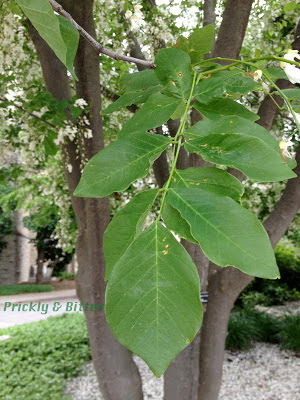Thursday, July 11, 2013
The tree with the yellow wood
Species name: Cladrastis kentuckea
Common name: American yellowood
Location: Western U Campus, London, Ontario
First of all, I've decided after doing a whole series of blogs about Sandra's garden that I'm going to start being more specific with where I took pictures of the plants I'm featuring in my blog. Featuring GPS coordinates would be silly (especially of rare plants, plus you would all also know where I live since I feature plants in my back yard a lot) and impractical since I don't own a proper GPS unit, but "Ontario" is a bit too vague. So this is the first blog to feature a more detailed location description. Blog evolution!
The yellowwood tree is a spectacular tree to have growing in your garden: it grows quickly but not very tall (the tallest yellowwood in the world is only 27 m tall), has a broad reach with its branches to provide a large patch of shade, and has incredibly attractive flowers during the spring. Unfortunately, it has a few downsides, too. The tree trunk tends to branch repeatedly close to the ground to get a "multi-trunk" type of tree so sometimes pruning is required to get enough space under it to park a lounge chair. Also, when the flowers start to drop it literally looks like it has snowed under the tree. This isn't necessarily a bad thing; it's a lot of organic material going back into the soil to support the soil microbes living in symbioses with the tree's roots. A lot of gardeners think it makes their lawn look messy, and so this tree is sometimes avoided. This is a shame since the seed pods, once they start to develop, are a great oily food source for animals during the fall and into the winter. Since these seeds are a preferred food source, very few of them make it into the ground to produce seedlings. Good if you don't want your lawn to look like a yellowwood nursery, bad if you're a yellowwood tree trying to reproduce. This same phenomenon can't be noted throughout the tree's range, nor is that seen further south; it actually has the potential to become an invasive weedy tree further south than its native range so be careful where you plant one. It is native to the United States as the name suggests, to a relatively small area bordered by North Carolina, Oklahoma, Missouri, Indiana and Alabama. Due to habitat loss it is becoming increasingly more rare throughout its native range, so if you live in that area and have the opportunity to plant a yellowwood, do it!
Aside from their obvious aesthetic value due to their flowers, yellowwood trees have traditionally been very valuable species in the woodworking industry. Because of the multi-trunking phenomenon they can't be used to produce many 2x4s, but they have been highly prized amongst furniture makers for their yellow heartwood to use for inlays and sometimes veneers. Wood turners have also valued yellowwood for its ease of carving yet very dense wood. Some of the most famous guns in American history also have their gunstocks made from yellowwood, although many other species of tree were favoured for this purpose.
Subscribe to:
Post Comments (Atom)








No comments:
Post a Comment